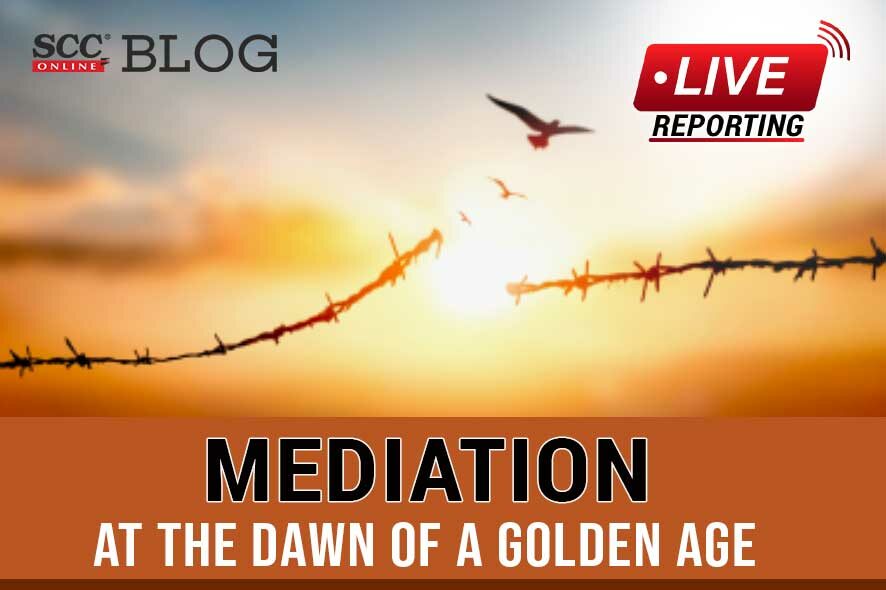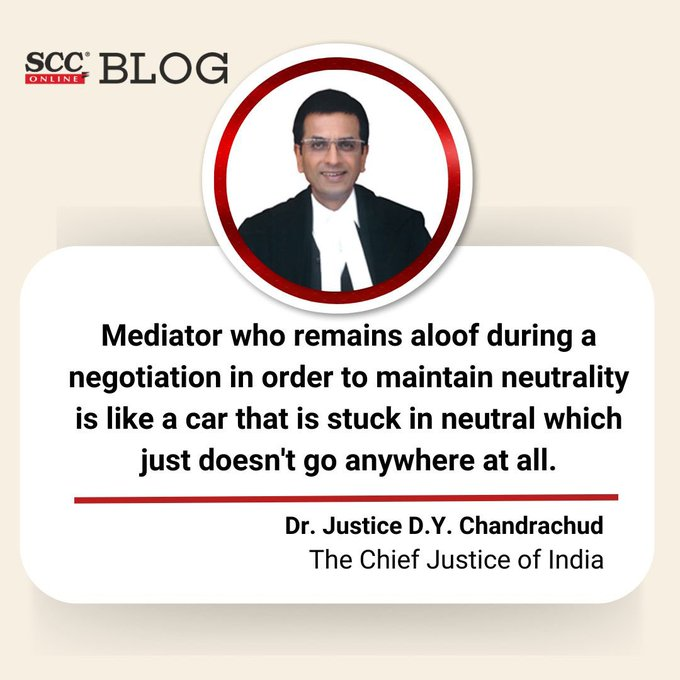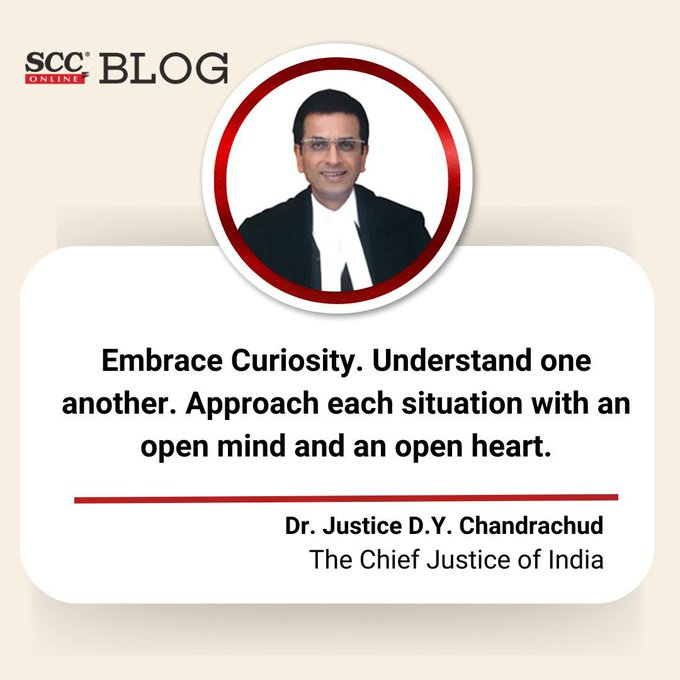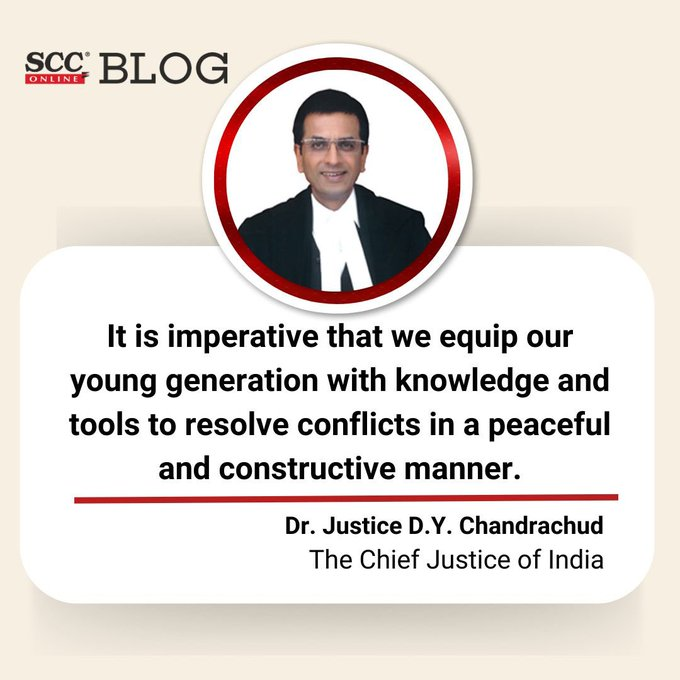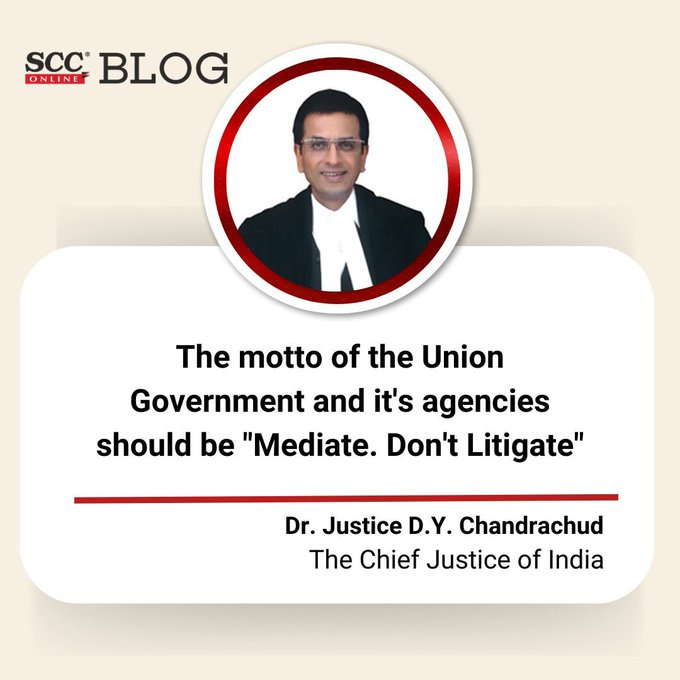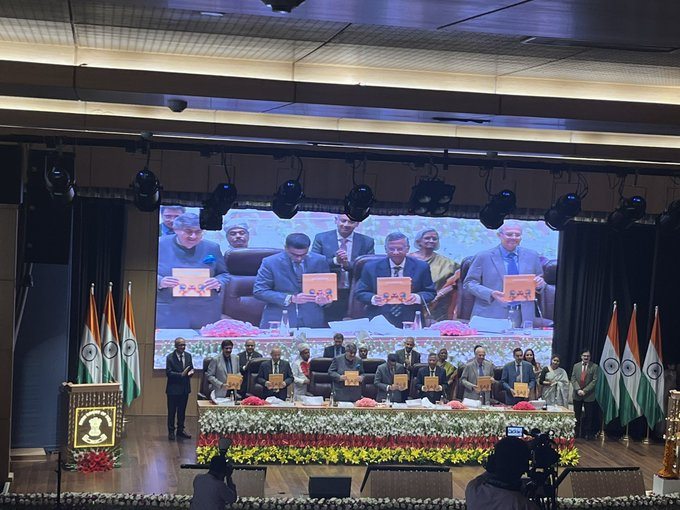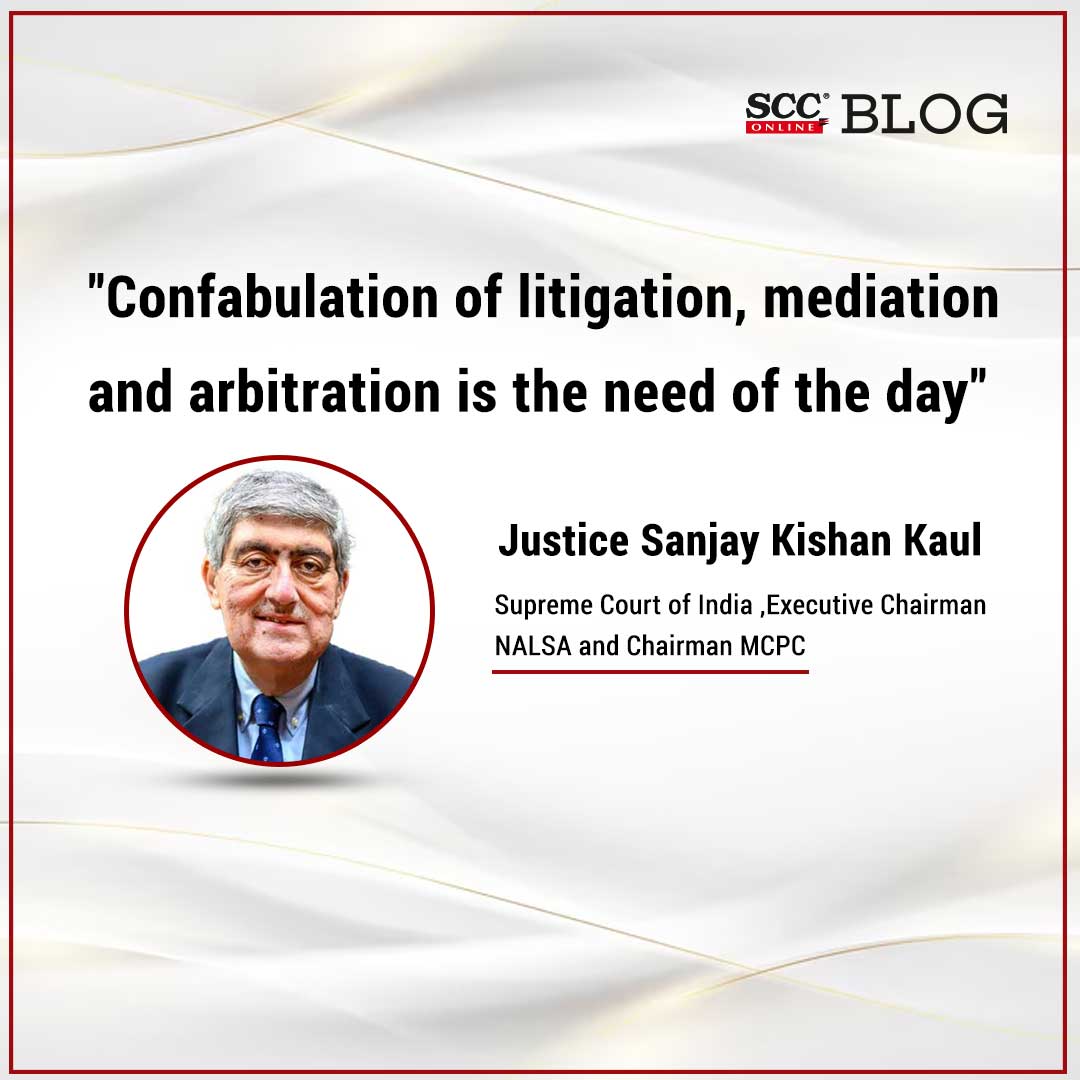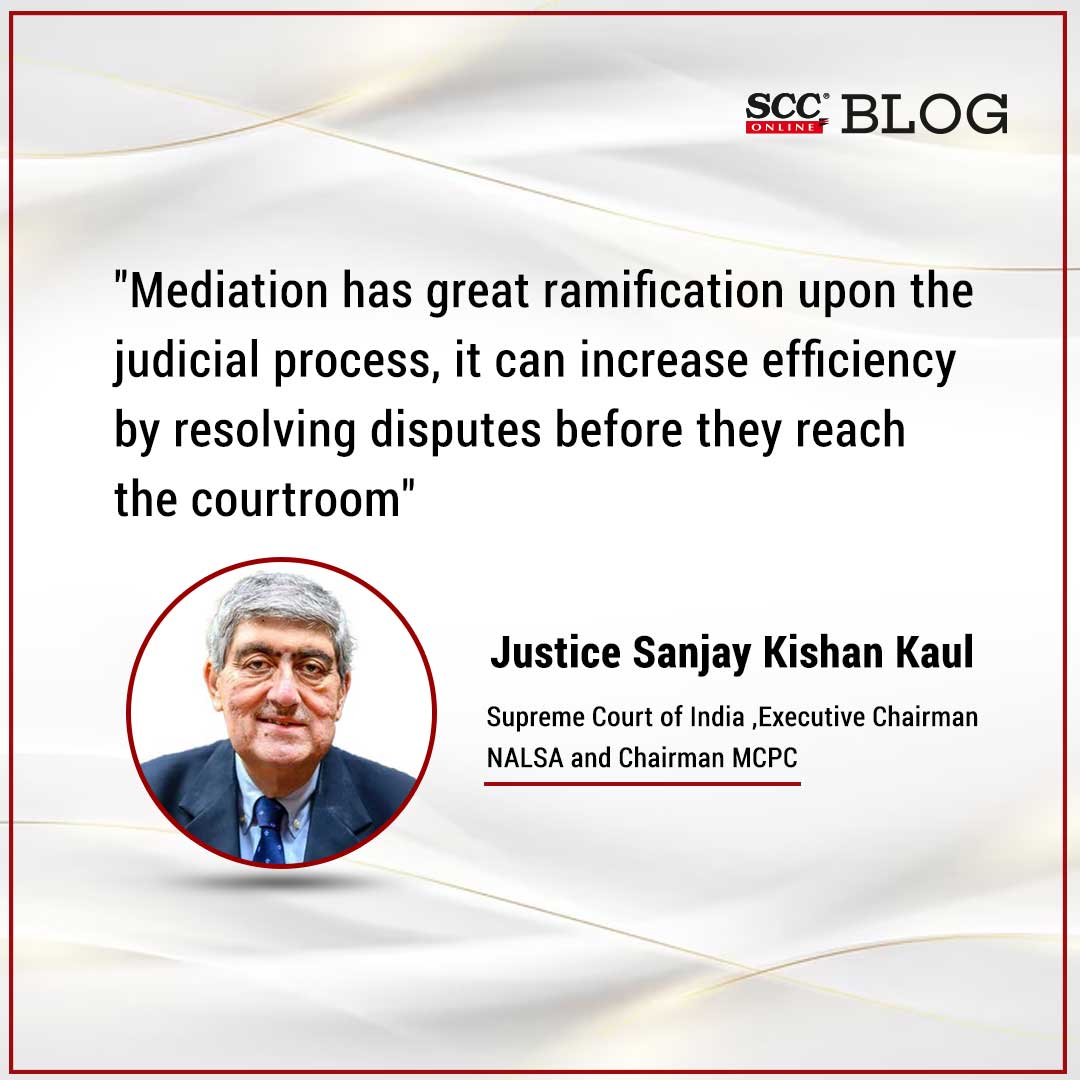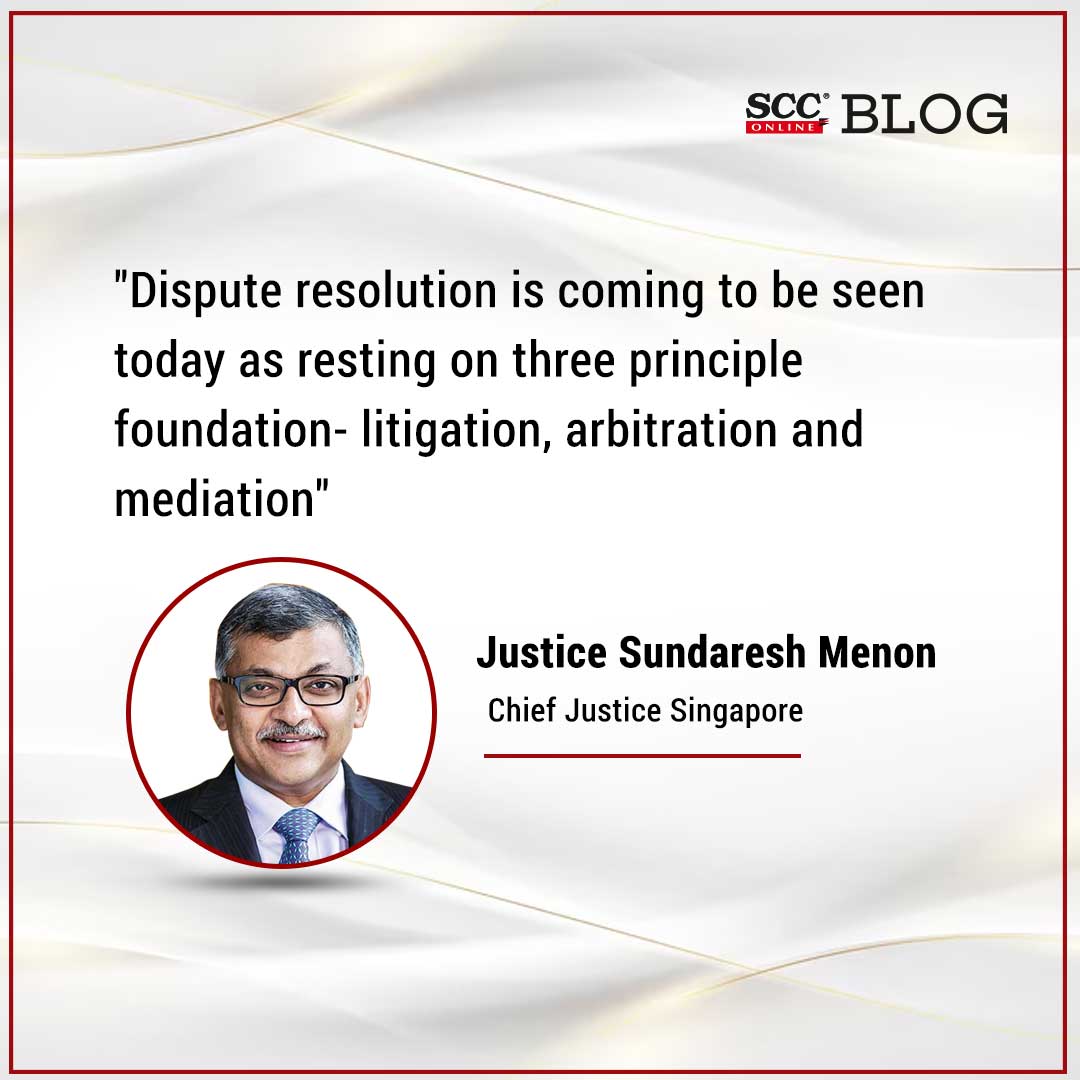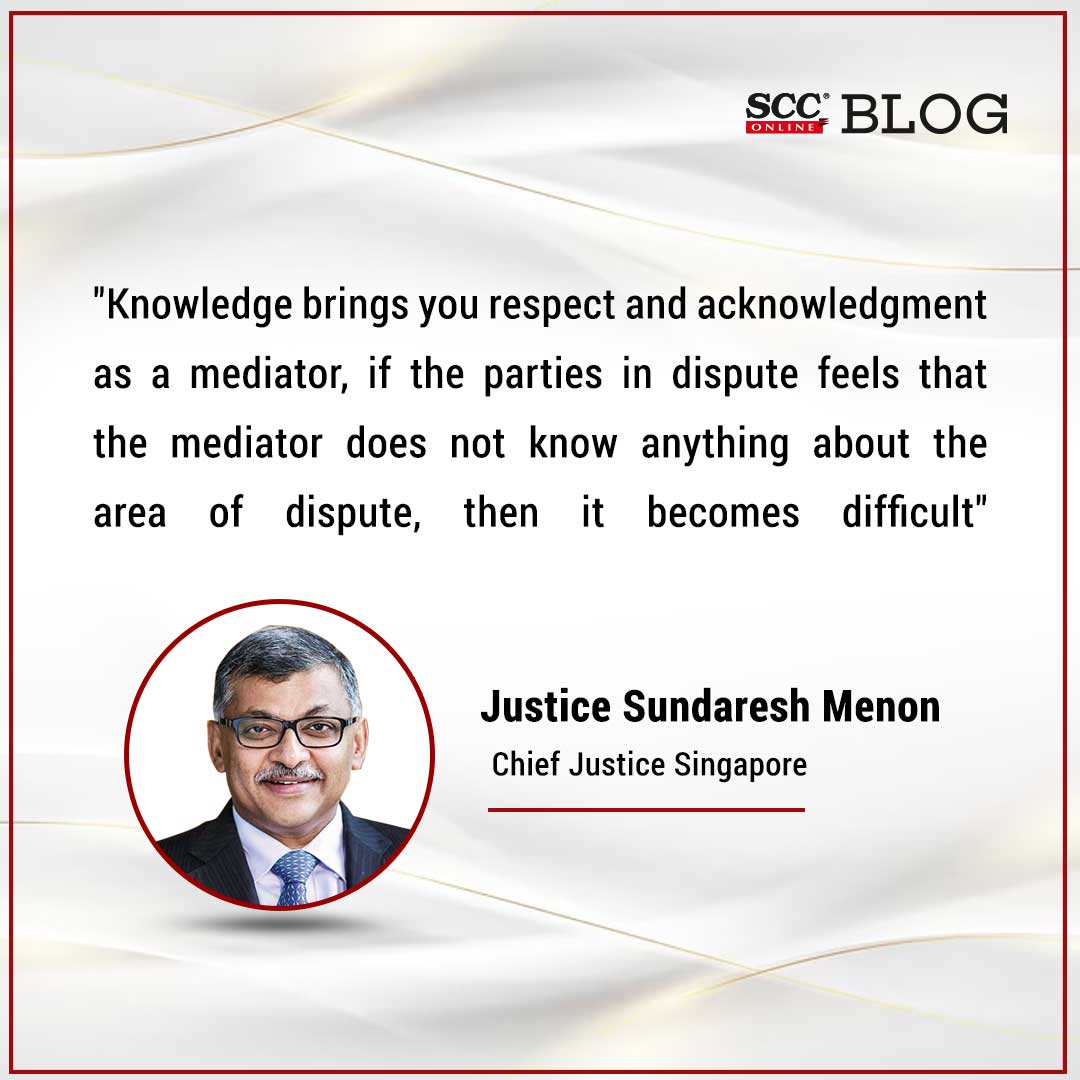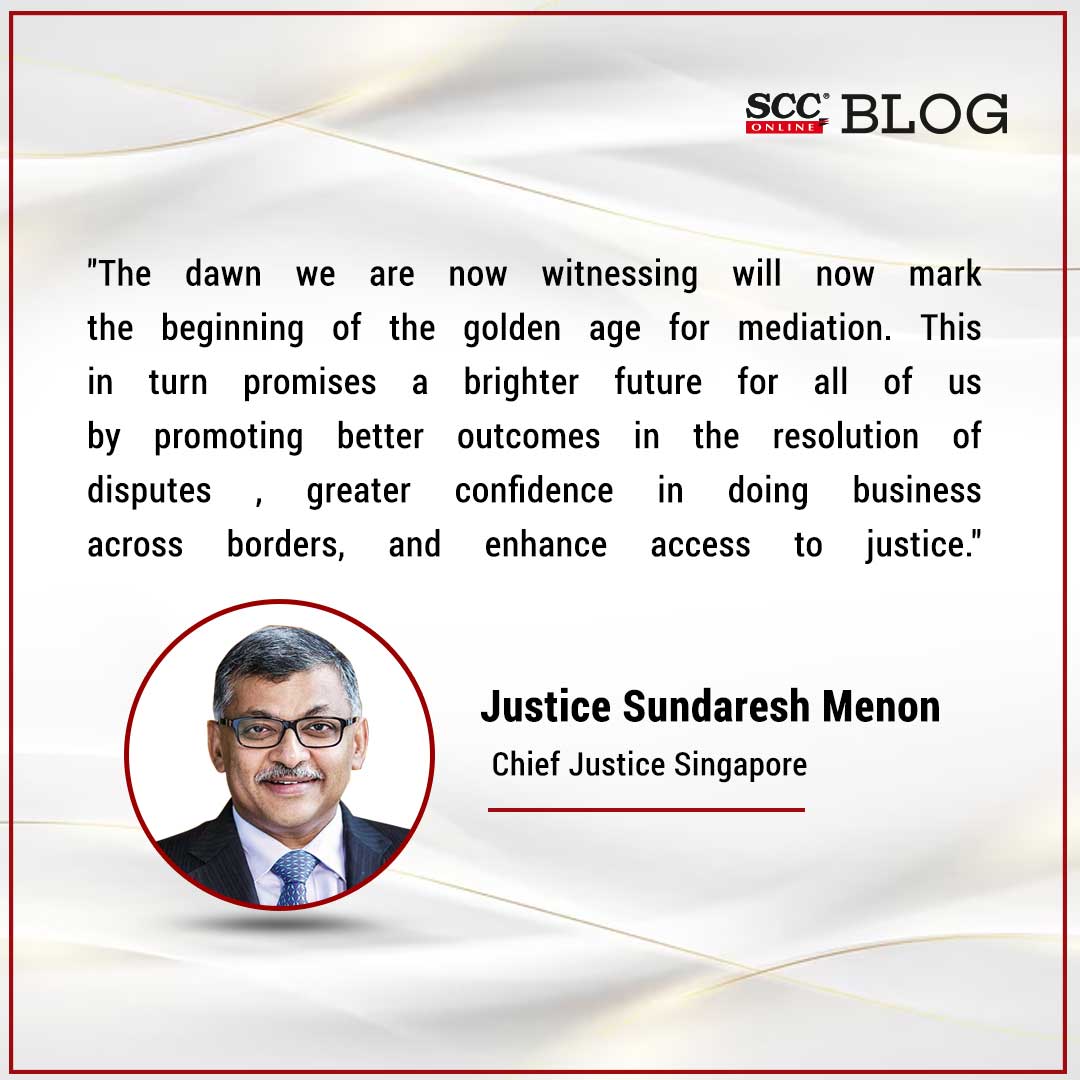The Delhi High Court Mediation and Conciliation Centre, known as Samadhan organized the Inaugral Session of National Conference on “Mediation: At the Dawn of a Golden Age” on 14-4-2023 under the aegis of National Legal Service Authority (NALSA) and Mediation and Conciliation Project Committee (MCPC). The Chief Justice of India, Dr. Justice D.Y. Chandrachud, Justice Sanjay Kishan Kaul, Justice Satish Chandra Sharma and Senior Advocate Mohit Mathur were present at the event. Here, we have covered significant parts of the event including the important pointers raised regarding the process of mediation, important announcements, launch of book on mediation, Samadhan mobile application, etc.
The National Conference commenced with the address of Senior Advocate Mohit Mathur, who is of the opinion that “Mediation simply works because in a society we are all meant to coexist”. Said Senior Advocate Mohit Mathur.
Dr Justice DY Chandrachud delivered his speech at the Conference where he remembered Dr B.R. Ambedkar on his birth anniversary and and said that Constitution drafting, and mediation may look unrelated, but they continue to be interwined as they share many normative goals, like dialogue, negotiation, compromise and consensus building formed bedrock of the making of the Indian Constitution. He further commented that “In a jurisdiction like India, where we hold values such as trust, community, social harmony and good relations on a high pedestal, mediation’s ability to envisage an alternative conception of justice which is more personalized, inclusive and democratic cannot be understated.”
CJI Chandrachud also pointed out the transformative character of mediation that it is a process which puts the decision-making authority in the hands of ordinary people – empowering them. Going further, he said that Mediation confers an avenue to citizens to chart a path forward and make the law less intimidating.
As he always promotes use of technology in justice delivery, CJI Chandrachud acknowledged that Online Dispute Resolution (ODR) services have the potential to go beyond traditional mediation. It will provide an opportunity to reduce time and cost of dispute resolution.
CJI Chandrachud commented on the role of law schools proposing that they can play a pivotal role in promoting mediation as an effective alternative to ADR mechanism. Law schools must incorporate mediation training into their curriculum focusing on developing skills necessary for effective mediation.
He also batted for curiosity among the key players in mediation with the words “A mediator with curiosity notices what was said by the parties, names what was seen and invites the parties to also become curious about their underlined motivation and interest. says CJI Justice DY Chandrachud Embrace Curiosity. Understand one another. Approach each situation with an open mind and an open heart.”
CJI Chandrachud said that “One of the serious problems of the young today in our society are our short attention time span. Mediation by encouraging youngsters to be an active listener can perhaps stretch those dying and short time spans.”
Justice S.K. Kaul batted for mediation in ADR with the words “I believe it’s a superior method of resolving disputes and must be opted first.” According to him, mediation is important for primarily three reasons
- It is a party driven process.
- Mediators are trained to help the parties reach a resolution and discuss issues respectfully. Mediator is like a taxi driver who facilitates the parties to reach their destination.
-
A strong mediation movement has ushered in India in past few years. Referral of disputes to mediation has found place in various Acts.
Justice Kaul also came up with some suggestions for making mediation a more effective mechanism:
- Reference to mediation by Judges;
- Lawyers must also be trained in mediation. Training sessions online must be encouraged.
- Training students to aware them about alternative methods of dispute resolution.
-
Training to mediators to maintain quality of mediations
Justice Satish Chandra Sharma quoted that the “Exercise of mediation is born out of societal morality as it promotes amicable resolution and reduces friction. Today the scope of mediation is expanding, and even complex matters are falling within its domain, however, the success rate is low.”
Introduction to Samadhan: Delhi High Court Mediation Centre
Senior Advocate Mohit Mathur introduced “Samadhan” being responsible for training and maintaining over 250 Mediators who are members of the Delhi High Court Bar Association. “Samadhan” also conducts training sessions for mediators all over India.
Justice SK Kaul said that “Samadhan is close to my heart. It is a unique endeavor run by the bar as a matter of trust between bar and the bench, initiated on an appeal made by the then CJ Justice Katju and accepted by the then President of the bar. These people played very important role in samadhan.”
Justice Manmohan expressed that Samadhan has held online mediation through COVID period and reached out to distressed people and helped them to resolve their disputes.
Important Announcements during National Conference on Mediation at the Dawn of Golden Age
Attorney Genetal R. Venkataramni proposed to set up Attorney General National Council of Mediation watch. He also announced AG National Award of Mediation Achievements for recognizing 5 achievers at the national level. On this, CJI Chandrachud added that the motto of the Union Government and its agencies should be “Mediate. Don’t Litigate”
Justice D.Y. Chandrachud acknowledged that the support of govt. and judiciary in establishment of mediation as a viable parallel process is one of the reasons for growth of mediation in India. The legal framework has continued to evolve to support and institutionalize a well-developed legal framework for mediation.
A Memorandum of Understanding (MoU) was also signed between Delhi High Court Mediation and Conciliation Centre “Samadhan” and Uttarakhand High Court with the aim to pace up mediation in the State and for other centers as well.
Samadhan Mobile Application
CJI Chandrachud inaugurated “Samadhan” Mobile App developed by Delhi High Court Mediation and Conciliation Centre and designed by Abhimanyu Chopra, Advocate and Mediator. The app is currently available for android users and gives one-click access to Samadhan cause list, calendar, explanation of mediation, why to choose mediation, details of the High Court committee, access to limited reading material, sign in features for the authorized logins of mediators, access to individual calendar invites for matters, assignment of rooms, access to individual caseloads and sample templates.
Book on ‘Mediation and Its Promise’
A book titled as ‘Mediation and Its Promise’ was also launched at the National Conference on “Mediation: At the Dawn of a Golden Age”
Justice Manmohan explained the idea through which the Book ‘Mediation & it’s promise’ was conceived when Justice Narasimha suggested that we adopt a format of a theme article written by an academic and other article written by distinguished experts who have engaged deeply in the subject in different ways.
Session 1 (Plenary Session) Mediation: At the Dawn of a Golden Age
Panelists: Justice Sundaresh Menon, Chief Justice Singapore and Justice Sanjay Kishan Kaul Moderated by Justice Manmohan and Ms. Sadhana Ramachandran
While talking about the immense potential of mediation to transform the phase of dispute resolution and sharing Singapore’s experience in this area, Justice Sundaresh Menon, Chief Justice Singapore said that dispute resolution is coming to be seen today as resting on three principle foundation- litigation, arbitration and mediation. Whereas the amicable resolution of disputes has historically played an important part in our society, the rise to the eminence of mediation as a key contributor to the rule of law and as a part of the justice system is quite a modern phenomenon.
He said that mediation’s place in today’s dispute resolution landscape should not be understated on account of its recency, because mediation offers some unique value propositions when compared to the alternatives. He explained why Singapore is at the dawn of the golden age for mediation, as its foremost challenge of enforceability, is being swept away by the Singapore convention on mediation.
While offering a few suggestions, he said that all of us grew up in the time when dispute resolution was seen to be synonymous with litigation and arbitration. They involve a neutral and impartial third party pronouncing upon questions of ultimate truth and applying the legal analysis to determine the rights and wrongs of a case after making factual finding and then applying law to them.
Justice Menon said that while the practice of dispute resolution has undoubtedly seen many changes over the past decades, the most prominent of these is the growth of international commercial arbitration and the most recent rise of the international commercial courts.
He also stated that arbitration and litigation each have its merits and demerits, purely adjudicative approaches to dispute resolution are bedeviled by certain challenges, some of these are long standing while others are new emerging and in some respects worsening, the first is the ever-increasing level of the time and cost that is there in the adjudicating process. This is rooted in the vital need for fairness in any adjudicative process, which in turn necessitates extensive procedural formalities and often protracted series of interlocutory steps to be taken to get a case ready for hearing.
Pointing towards the total cost of litigation conducted by fortune 500 companies that is as much as one-third of the companies after tax profits, he remarked that this is an issue that plaques litigation and perhaps to a greater extent to the international commercial arbitration, where costs awards in the larger cases routinely exceeds US ten million dollars.
Remarking on the complexification of disputes, Justice Menon said that it is possible that disputes will become so large and so complex, that a human may not be mentally capable of absorbing and processing all the material.
Commenting on arbitration he said that, while arbitration was once thought to offer a better process by procedural flexibility and proportionality. It too has become dogeared by its own challenges. Further, due process paranoia has caused arbitrators to become overly cautious and to indulge the dilatory tactics of parties for fear of their awards being set aside.
As per Justice Menon, all the power over the outcome is vested in the hands of the adjudicator, who will be assisted by counsels, but adjudicator assessment will turn on issues which are designated as having legal significance by the dictates of legal doctrines.
Further, he suggested that we should be very careful not to equate dispute resolution with adjudication, nor should we think adjudication is the primary or default or preferred means of dispute resolution. Instead, we should recognise , that dispute resolution comes under multiple, co-equal forms, each with its own role and values, both adjudication processes like litigation and arbitration and non-adjudication processes like mediation.
Justuce Menon offered few suggestions for ushering in this golden age:
To raise awareness of the emence importance of the Singapore convention on mediation and encourage its adoption by States and its use by commercial parties.
To pursue excellence in the practice of mediation, to boost the reputation and legitimacy that mediation enjoys.
Lastly, he said that each adjudicator or mediator presiding over a stage of the dispute holds only a piece of the puzzle, and they will need to be distinctly aware that, how their roles fit together in the management of the dispute, as a whole.
Justice Sanjay Kishan Kaul, Judge, Supreme Court of India and Executive Chairman NALSA and Chairman MCPC said conflicts are inevitable in any society, when and how they will arise cannot be controlled, however what can be controlled is the way people choose to resolve these conflicts.
He said that whenever, and wherever possible, solutions for any conflict must flow from the parties themselves
He opined that talented lawyers and favorable precedents may help parties win the case, but in the process the parties lose out on the important personal or commercial relationships. Hence, if the parties show inclination towards the non-conventional methods, they have already taken a step towards working towards a relationship that has turned sour.
He disagreed with the concept that panchayat system is synonymous with mediation, as in the panchayat system the parties have a social compulsion, they did not have the freedom to choose the solutions. The current mediation process is more evolved, the parties are not distracted by the mediators.
Justice Kaul said that, as a Judge he often find great satisfaction, if parties agree between themselves, than possibly writing some very great nuance of law which may be placed for judicial interpretation.
As per him, family and commercial disputes are more receptive to mediation as there is an enhanced focus on maintaining the relationships during and after the resolution of the conflict, which often becomes impossible once parties have been through the tedious Court process.
Commenting upon role of mediation upholding the Rule of law , Justice Kaul said as every student of law is aware, rule of law is a nebulous concept, and by quoting Chief Justice John Marshall famous formulation in William Marbury v. James Madison, 5 US 137 (1803) that “ours is the Government of law and not of men”, Justice Kaul said that this points towards Rule of law as a doctrine concerning the supremacy of rules to the whims and fancies of individuals and institutions, Rule of law is deeply connected to the idea stability , equality and ultimately individual’s freedom guaranteed by the law.
Session 2: Developing an Institutional Culture for Effective Mediation in Courts
Panelists: Justice S. Ravindra Bhat, Justice N. Kotiswar Singh and Senior Advocate Sriram Panchu
Session Moderated by: Justice Sanjeev Sachdeva and Senior Advocate Sudhanshu Batra.
Since the panelists were supposed to discuss “Developing an Institutional Culture for Effective Mediation in Courts”, Justice Bhat was asked to discuss comparison of Court annexed mediation since some of the high courts and subordinate courts in India have setup court annexed mediation which have led to institutional mediation at court level and some of the success stories are amazing. Justice Bhat took some pointers and explained that “The first and foremost reason being that the ownership – active participation and involvement of lawyers drives a mediation. The first part is introduction/ idea of mediation to be floated proactively by judges and lawyers. Secondly, as long as the judges/ judicial system play a supportive role in terms of infrastructure, funding, manpower, etc., is the recipe for success of mediation centers. Thirdly, every institution has to grow, contributing to success. Fourthly, the continuous outreach to the members of the public wherein a lawyer owned mediation center and judges step back and play a supportive role would help.”
When seeking his opinion on training of Judges to improve the mediation process and the kind of impact expected from institutionalizing mediation, Justice Bhat replied that “for mediation to be a success, educating the Judges is very important. When you are in mediation, practicing calmness is one of the key components wherein you unclutter your mind and cut out the noise. The Judges need to be sensitized about the process so that if parties were able to re-establish communication, there would be no need for a Court.” He further added that if we take mediation as the process to remove dust from a relationship and restore the element of confidence in each other, it is going to take some time. Identifying the stage at which parties should be referred for mediation is crucial. One thing that should be taken care of is that what transpires in mediation should never be shared in the Court.
Senior Advocate Sriram Panchu was of the view that Developing an institutional culture for effective mediation in courts – Culture is both a broad and mixed one encompassing state of mind, attitude, approach and behavior. He came up with three short phrases capture the essence of mediation:
- Talk Works
- Settling for more (as against settling for less)
- Gray matters (as against black or white)
He also came up with a creative idea that to encourage mediation, there should be a reflexing question: “Why are you not mediating this case? Is the stage where we want to come to.” On the question of whether mediation reduces delay and costs improving access to justice resulting in higher quality of settlement?”, he is of the view that mediation can dramatically reduce time and cost getting the practical solution that people want being a participatory process.
The panelist came up seeking steps to be taken to sensitize the stakeholders, change the mindset of lawyers to encourage mediation when Justice N. Kotiswar Singh expressed that “Spreading awareness among lawyers and litigants is very important. The fear of losing income by resolving disputes without much involvement is a genuine concern who should be affirmed that end of a dispute is not the end of litigation. We need to help resolving the existing disputes amicably without losing much time, energy and cost. Lawyers’ apprehension that mediation may demonstrate their inability to win the case, they should be conveyed that this is an opportunity to empathize problems and help litigants with a faster solution. Also, lawyers representing a client think that they are not a part of the mediation process being reduced to a secondary role, but they should be sensitized that they are respecting autonomy of parties to explore other means of dispute resolution. The continuous process of coordination between the lawyer and litigant is a key to success in mediation.”
Justice Kotiswar also touched on the root of the legal profession that “when we pass out of law schools and colleges, we are taught to win the case and try to get maximum advantage for our own clients. We need a change in the approach, psychological training and there has to be a paradigm shift from Win-Defeat situation to a Win-Win situation.” He further added that law has not really incorporated mediation and it is the need of the time to regularize, to codify the viable alternative process of dispute resolution. He pointed out that High Courts have framed some rules, but it is not percolated down to the people.
Session 3: Building Trust in the Mindset of the End User of Mediation
Panelists: Justice M.M.Sundresh, Mr. Braja Behari and Senior Advocate S. Susheela; Moderated by Justice Navin Chawla and Senior Advocate Rajeev Virmani
Justice MM Sundresh, Judge, Supreme Court of India, explaining concept of mediation said that a litigant hailing from a village, he has to be plainly informed about the pros and cons of dispute resolution system. It is an opportunity for him to resolve the conflict which he is facing. Therefore, at the pre mediation stage adequate exposure must be given to an individual who is willing to explore mediation.
The process of mediation should create trust. Any institution can only excel if the litigant has got trust in it. To have trust, we need to have good, competent mediators. The individual concern should be given the option to choose his mediator.
Mr. Braja Behari, Mediator and Trainer said that the parties are not familiar with the process of mediator and therefore it is incumbent upon the mediators to be satvic and be kind and not be in a rush and be very calm. As mediators, our focus is on process and less on content. That does not mean we have to be an expert, but we must have sufficient knowledge, especially of law.
Senior Advocate S. Susheela said that in an average lifespan of any litigation which runs for 10 years, these 60-90 days of mediation should not bother the parties.
She said in mediation we try to understand why this person is doing what he is doing, we try to give him more time, that is called setting an atmosphere, where the person is asked to express all his concerns. That’s where this whole process gets settled and his earlier intention not to participate in mediation genuinely will get transformed.
As per her in mediation philosophy, their idea of success or their idea of winning is entirely different than what mediators make them understand through the process, in order for you to win it does not mean your opponent should lose always. This concept is slightly brought in through the process.
Session 4: Preparing for a Mediation Law in India
Panelists : Justice Sanjiv Khanna, Justice A.K.Sikri (Retd.) Dr. Niten Chandra and Mr. Anil Xavier
Moderated by Justice Sudhir Kumar Jain and Mr. J.P. Sengh
The session was started off by a question put by Justice Sudhir Kumar Jain to Justice Sanjiv Khanna on Whether Mediation will become a new tool for providing justice. Justice Sanjiv Khanna pointed out various issues initially in bringing mediation such as:
- How do we make people aware of modern ways of dispute resolution?
- How do we reach out to public?
All these issues resolved and Mediation started taking their baby steps. Justice Khanna pointed out to the stats that 9 Statutes now refer to Mediation. However, still the success rate is low. However, the good thing is that the reference to mediation is increasing. Justice Khanna also shown concern on the number of trained mediators.
Mr. J.P. Sengh, Senior Advocate further asked a question to Justice AK Sikri on fully funded community mediation centres by State or Central Government to which he quoted that to develop mediation, yes Government, private institutions and other NGO’s has to come together to make this a big success.
Taking the discussion ahead, Justice Sudhir Kumar Jain asked Mr. Anil Xavier whether Pre-Litigation be made mandatory in all types of dispute resolution before they are filed before court? Mr Anil Xavier thrown a light on the discussion of Parliamentary Committee gave an opinion that the Pre-Litigation should not be made mandatory as it might delay in justice delivery. It can create an additional tool in the hands of litigants to delay the process. Mr Xavier also quoted that once the Law is made, no one has to force pre-litigation on them but they will automatically accept Mediation as the first step.
VALEDICTORY
Mr. Sandeep Sharma Honorary Secretary, Delhi High Court Bar Association gave a Felicitation Address at the Conference.
Mr. Braja Behari, Mediator & Trainer addressed the audience by sharing anecdotes of his professional experiences.
Special Address given by Justice P. S. Narasimha Judge, Supreme Court of India focussed on the enactment of Mediation Law. Justice Narshimha discussed the below topics in his speech.
1. Adversarial Litigation didnt work well for us.
2. Mediation is the only way forward.
Justice Sanjeev Sachdeva Judge, Delhi High Court gave the concluding remarks.
Ms. Veena Ralli Organising Secretary, Samadhan delivered the vote of thanks.
Report prepared by Ridhi Khurana and Apoorva Goel.



